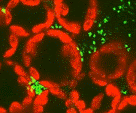Plant Pathology Department
Date of this Version
2014
Citation
Funnell-Harris, D. L., Sattler, S. E., and Pedersen, J. F. 2014. Response of Fusarium thapsinum to sorghum brown midrib lines and to phenolic metabolites. Plant Dis. 98:1300-1308.
Abstract
Sorghum lines were bred for reduced lignin for cellulosic bioenergy uses, through the incorporation of brown midrib (bmr)6 or -12 into two backgrounds (RTx430 and Wheatland) as either single or doublemutant lines. When these lines were assessed for resistance to Fusarium thapsinum stalk rot, a cause of lodging, they were as resistant to F. thapsinum as the near-isogenic wild type. Peduncles of newly identified bmr lines from an ethyl-methanesulfonate-mutagenized population, inoculated with F. thapsinum, were as resistant as the wild-type line, BTx623. One bmr line (1107) had significantly smaller mean lesion lengths than BTx623, suggesting that a mutation is associated with reduced susceptibility. Growing F. thapsinum on medium with ferulic, vanillic, sinapic, syringic, and caffeic acids (phenolic compounds derived from the lignin pathway and elevated in different bmr lines) indicated that F. thapsinum was tolerant to these compounds. When eight other sorghum fungi were tested for response to the presence of these compounds, ferulic acid inhibited these fungi. Most of the phenolics inhibited F. verticillioides and F. proliferatum. Accumulation of phenolic metabolites in bmr plants may inhibit growth of some sorghum pathogens, while other factors such as aromatic phytoalexins or salicylic acid may be involved in resistance to F. thapsinum.


Comments
This article is in the public domain and not copyrightable. It may be freely reprinted with customary crediting of the source. The American Phytopathological Society, 2014.